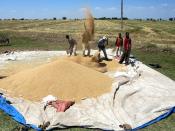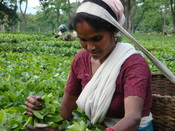SummaryGlobalization and liberalization have popularized the concept of contract farming, whereby a farmer enters into a contract with a processing/marketing firm to supply a pre-arranged quantity and quality of produce at a pre-arranged price and time. Theoretically, contract farming is attractive to the farmer because it gives him access to additional sources of capital, brings in new technology, and ensures a more certain, and possibly better, price for his produce.
Contracts could be of three types;(i)procurement contracts, under which only sale and purchase conditions are specified;(ii)partial contracts, wherein only some of the inputs are supplied by the contracting firm and produce is bought at pre-agreed prices; and(iii)Total contracts, under which the contracting firm supplies and manages all the inputs on the farm and the farmer becomes just a supplier of land and labor.
The relevance and importance of each type varies from product to product and over time these types are not mutually.
Whereas the first type is generally referred to as marketing contracts, the other two are types of production contracts.
The contract farming company benefits because the system makes smaller demands on scarce capital resources, is an alternative to costly and risky corporate farming, and often provides access to unpaid family labor and state-aided agricultural schemes.
Proponents of agribusiness promotion argue that contract farming leads to big jumps in income and employment in agriculturally backward regions. It increases low levels of productivity and eliminates instability in production. Thus, overall, it puts the local economy on a dynamic path to growth and development.
In political economy terms, though, contract farming is viewed as capitalist penetration of agriculture for capital accumulation. It is seen as a way for agribusiness companies to exploit the weak farming sector in order to maximize their own profits.
This paper looks at the basic economic rationale of contract farming. It explores the existing practices and their implications. It concludes that there are many imperfections in the method that must be addressed if contract farming is to bring benefits to both: producer and distributor.
IntroductionAgriculture in India still engages about 58% of the work force and contributes about a quarter of the GDP (Table 1). A very large majority of the farmers/cultivators belongs to the category of small and marginal holders. The number and proportion of such holdings have been growing over time. They constituted 68.15% of the total operational holdings in 1971-72 but their proportion increased to 80.59% in 1991-92. The area cultivated by them has grown from 24.01% of the total in 1971-72 to 34.3% in 1991-92. The share of marginal and small holdings increased to 61.6% and 18.7% respectively by 1995/96, altogether account for 80.3% of all holdings. Most of these farms are family farms characterized by use of household labor, production for consumption, stock, and sale in that order, highly diversified to reduce risk, and weak market linkage, though improving with commercialization. These farms have socio-cultural, economic and technical dimension in their management and are quite complex and dynamic institutions in themselves.
On the other hand, the number of farms in the largest category declined and the average size of the largest category was falling. Further, large holdings (>4 ha) were estimated to decline to only 7% by 2000-2001 and 5% by 2010-2011 and account for only 36% and 28% of the area respectively. Given this general picture, it is not surprising that the average size of operational holding has been declining since the 1960s and was only 1.57 hectares and average size of ownership holding only 1.14 hectares in 1992. Small farmers (with holdings of <2 ha) accounted for 83.9% of all operational holdings by 2003. Also, small farmers (including landless) had higher livestock ownership (60-80% of all livestock population) including cross-bred cattle where 12-20% small farm and landless households owned these animals compared with only 8-15% in case of larger farm households. By 2002-03, the average size of operational holding has come down to 1.09 hectares and proportion of small and marginal holdings in total operational holdings as high as 86%.
Table 1: Comparative contribution of agriculture to GDP in India(At current prices in %) 1980-2003Years/Sector 1980 1990 2001 2003Agriculture 38.1 31.1 24.7 22.2Industry 25.9 29.3 26.4 26.8*Service 36 39.7 48.8 51.0*New economic policyIndia has already made significant progress in the trade and industrial sectors, the focus is now shifting towards bringing about structural reforms in other sectors, especially agriculture in terms of mode of organization of production. This is being attempted in order to bring in better efficiency of input and output markets and promote growth performance of the sector, ultimately resulting in rural poverty reduction in India. Though India economy has grown at a high rate (6%) during the last decade, agricultural growth rates have lagged far behind (1-2%). Additionally, the agrarian distress and ecological crisis in the largely small farmer dominated agrarian economy has made matters worse in the presence of globalized and liberalized agricultural markets. The agricultural reforms are being undertaken with primacy given to public-private partnership and a significant role being assigned to private corporate sector in rural development and poverty reduction through trickle down of growth. Contract farming is one such initiative attempted in many Indian states.
A farmer may prefer a contract due to:ÃÂ Access to additional sources of capital,ÃÂ A more certain price,ÃÂ Access to new technology and inputs.
For a processor or distributor, contracts:ÃÂ Make smaller demands on scarce capital resources, Are an alternative to costly and risky corporate Farming,ÃÂ Provide an access to unpaid family labor and a route to make use of State funds directed at farmers by development agencies.
At a more macro-economic level, contracting can help to remove market imperfections in product, capital (credit), land, labor, information and insurance markets. But, contract farming is viewed, in political economy terms, as one mode of capitalist penetration of agriculture for capital accumulation and exploitation of farming sector by the agribusiness companies.
The review reveals that in most of the situations:ÃÂ The contracts are highly biased against the Growers, firms favor large farmers and relatively better endowed regions,ÃÂ Companies work with small farmers only when the area is dominated by small farmers or where the farmers are dictated by the state or the nature of the crop,ÃÂ There is ÃÂagribusiness normalizationÃÂ in contract price over time,ÃÂ There is little bargaining power of the farmer due to ÃÂmonophonyÃÂ of the firm,ÃÂ Farmers compete with each other to get contracts,ÃÂ Companies refuse to buy or reject with quality Standards manipulation,ÃÂ Small farmers are excluded,ÃÂ There is inter-locking of markets,In India, where contract farming is prevalent across regions and crops, it has moved from firm- farmer (two-party) system to tri- and quad-partite arrangement where in state and its apparatus have been involved, e.g. in Punjab.
Fig 1.1Fig 1.2There have also been some cases of group contracting. In both, state and agribusiness models, contract growers have faced many problems like:ÃÂ Undue quality cut on produce by firms,ÃÂ Delayed deliveries at the factory,ÃÂ Low price andÃÂ Pest attack on the crop with no compensation.
The production, marketing and distribution of agricultural products have all become increasingly sophisticated. Modern advances in technology have made it feasible for agricultural products to be produced to ÃÂspecificationÃÂ and preserved in a fresh condition. The sheer scale of operations has also been increasing, and new selling methods have emerged, emphasizing the need for a brand image based on consistent quality.
Consumers too are becoming more discriminating in their tastes. They demand better quality and year-round supplies. All this has given an impetus to the search for ways of improving the co-ordination of production, processing and distribution, especially with respect to timing and quality control.
History of Contract FarmingContract farming emerged as an important phenomenon in the developed countries of the West during the 1950s and the 1960s. By 1980, about one-third of the total US farm output, and as much as 100 percent of poultry meat, milk and certain vegetables, was produced under contracts. Even in Tasmania island of Australia, by the mid-1990s, 95 percent of the potato production was under contracts compared to almost nil in the 1950s. On the other hand, in the developing countries, the Multi-National Corporations (MNCs) brought in the system of contract farming during the late 1970s and the early 1980s. Besides private and multinational enterprises, contract farming is also practiced by statal and parastatal agencies in many countries in different commodity sectors like tea production in Kenya, tobacco and livestock in Thailand, rubber in Malaysia, coconut in Indonesia, palm oil in the Philippines, and seeds in India.
For different reasons, both farmers and farm product processors/distributors may prefer contracts to complete vertical integration. A farmer may prefer a contract which can be terminated at reasonably short notice. Also, contracting gives access to additional sources of capital, and a more certain price by shifting part of the risk of adverse price movement to the buyer. Farmers also get access to new technology and inputs through contracts which otherwise may be outside their reach.
Cases of Contract Farming in India1. IEEFL, Pune (subsidiary of the Ion Exchange India set up in 1995 in Maharashtra, Tamilnadu and Goa)Their plantations mainly include fruit trees with a total of 12 farms with four in Tamilnadu, seven in Maharashtra and one in Goa. About 1500 acres is made up by about 650 acres in Tamilnadu, 750 acres in Maharashtra and 100 acres in Goa.
The land put to CIS was bought from farmers and was cultivable wasteland. Each farm is in a compact zone in each State and mostly in Konkan region. The land was bought at the rate of Rs. 25-30,000 per acre and it provides for 80:20 sharing of profits from plantations, now through exports of fruits, with 80% going to the investors after meeting all expenses.
There is a formal agreement with share holders which is renewed every 5 years. The company is only managing the farms on behalf of the owners. Now, certified organic production for domestic and export markets are undertaken on these farms.
2. Jamnagar Farms Pvt. Ltd. - a subsidiary of Reliance Industries(Mukesh Ambani group) Gujarat, and PunjabIt deals with agro forestry and horticultural crops 7500 acres of farm land which has mango plantations occupying 450 acres that makes it the largest mango orchard in Asia. The farm was originally set up as an environmental protection measure near its refinery. Now, it is being seen as a profitable venture in itself. The company has invested Rs. 10 crore on the farm during the last 3-4 years and plans to have such farms in other states like A.P., Maharashtra and Karnataka.
The projects are expected to take seven years for breakeven and give 30% return after that. More recently, it has been allotted 625 acres of government owned panchayat and common land for its Rs. 5000 crore agribusiness project in the state of Punjab out of which 300 acres are prime agricultural land. Some of this land (150 acres) is on a 30-year long lease and the rest is bought by the company. It is undertaking export oriented corporate farming (50%) also planning to sell the farm produce in domestic market through Reliance Retail outlets.
3. Anil Dhirubhai Ambani Group (Reliance) PunjabFruits and vegetables and purchased about 3,500 acres of land from farmers. This would be a multi-product SEZ that would have separate units dealing in food and agricultural produce, the automobile, industry and garments and apparel, among other items. By locating the SEZ in Mansa, the company intends to cater to Haryana and Rajasthan and also be closer to the National Capital Region when approached via Hisar.
4. SYP Agro located in Ahmedabad and Gujarat mainly exports Onions, vegetables and other spices.
Contract farming is leading to huge gains in the agricultural sector because it has broken the traditional practices and adopted new Farm-to-Retail plans.
Vicious cycle broken:Low risk taking ability >>> Low investment >>> Low productivity >>> Weak market orientation >>> Low value addition >>> Low margin >>> Low risk taking abilityFig 1.3This SCM model in contract farming in India is currently being practiced by multinational firms like Cadbury (cocoa), Pepsi (potato, chilies, groundnut), Unilever (tomato, chicory, tea, and milk), ITC Ltd. (tobacco, wood trees, and oilseeds), Cargill (seeds), domestic corporate like Ballarpur Industries Limited (BILT), JK Paper, and Wimco (in eucalyptus and poplar trees), Green Agro Pack (GAP) Ltd., VST Natural Products, Global Green, Interrgarden India, Kempscity Agro Exports, and various government and semi government agencies, especially in seed production and perishables like vegetables and fruits, with varying degrees of success with individual farmers. There are many banks which provide finance for contract farming. These include NABARD, SBI, ICICI Bank and UTI Bank. Contract farming in India by the corporate sector has so far been more of a case of buy back, and input supply credit.
In Tamil Nadu, Appachi Cotton Company (ACC)It has undertaken contract cotton farming with eight farmer groups from 32 villages in Coimbatore district for bringing 1050 acres under cotton contract farming. The contract growers form an Association of Persons (AoP). The major features of the model adopted by ACC are: one village ÃÂ one SHG, one village ÃÂ one variety of cotton, cotton crop insurance, door delivery of agricultural inputs, crop loans at 12 percent rate of interest, farm service centers, assured buy back from farmers though farmers are free to sell elsewhere if they find prices higher than contract price, contamination control from farm to factory and synchronized sowing of crops.
It is also popularizing concepts like hand picked cotton to improve quality of produce. The farmer representatives will monitor cultivation of contracted cotton in the villages. In 2002, they worked with 3500 cotton farmers in four states and achieved an average profitability of Rs. 25000 per hectare in Bharuch district of Gujarat and Rs.10000 per hectare in Andhra Pradesh. In M. P., it was only able to lower the cost by about Rs.2000 per hectare. Marico Industries has a tie up with oilseed cooperatives in Maharashtra for safflower oilseeds wherein it provides working capital, infrastructural facilities, managerial inputs, and job work of crushing the oilseeds to these co-operatives.
Ion Exchange Environ Farms Ltd., a subsidiary of Ion Exchange India Ltd. undertakes contract farming with Community Grower Groups (CGG) having large acreage, on a profit-sharing basis.
Prime Bio Products (India) Ltd. in Coimbatore has a programmed wherein 10-15 cotton farmers form a self-help group which has office bearers who work with company under contract and various other agencies like banks and monitor the performance of the group so far as contract is concerned. The National Dairy Development Board (NDDB, a development agencyÃÂs) Fruit and Vegetable project, now under the Mother Dairy Fruits and Vegetables Limited (ÃÂSafalÃÂ brand), procures fresh produce directly from 75 Growers' Company.
The Case against Corporate Farming and EvidenceThe opponents of corporate farming argue that allowing companies to buy land will make farmers landless since the companies would offer prices which may be too tempting for the poor farmers to resist and they may not be able to negotiate fair prices for their land. Land owners, therefore, would run the risk of becoming landless. Further, other stakeholders in such land other than the title holder, like women or children, may run a risk of losing access to such land and therefore food security and social status. This has serious gender implications in an already gender biased rural context. To avoid such a situation, it is proposed to allow only leasing in of land by the companies and to share the company profits with the farmers who will lease out land to the companies. On both these fronts, the chances of agriculturists being taken for a ride by the companies are quite highAlso, in a country where the population pressure on agricultural land is already high, it is debatable whether captive or corporate farming is the most optimal use of agricultural or even degraded land.
Thirdly, the investing capital in land purchase per se does not yield profit, irrespective of the existence or absence of ceilings on land ownership. Such an investment by a business enterprise is solely for the purpose of rent-seeking and/or for unearned speculative capital gain in a situation of fast rising land prices. Corporate demand for removal of ceilings makes sense only in the presence of such a motivation. But, this is contrary to the nature of a corporate, capitalist enterprise driven by profit seeking. Such an investment is also socially wasteful of capital, even otherwise a scarce social resource. It merely leads to the transfer of land from one hand to another .In fact, it is known from experiences of other developing countries, and of India where contract farming is now widespread, that agribusiness firms producing for export tend to undermine the local food production systems as they go in for export-oriented non-food crops by displacing area under basic food crops which is so crucial for local and national food security and exploit farmers.
Further, the experiment of corporate farming in many developed and developing country situations did not succeed largely due to the internal problems of the agribusiness firms. For example, in Iran, most of the firms failed, when they were given large chunks of land for cultivation, due to the mismanagement which resulted from the lack of relevant experience.
The main reasons were managerial in nature, like neglect of field improvement, no contingency planning, under-capitalization, managerial inflexibility, and poor labor relations .The external reasons included diseconomies of scale which suggested that there were limits to farm size growth worldwide. Large-scale corporate farms failed in UK, Venezuela, Ghana, Brazil, and Philippines besides Iran, despite the presence of significant ÃÂexternal economies of scaleÃÂ in terms of subsidized inputs including land, low interest credit, and tax and duty benefits and a major adverse fall out of such schemes was displacement of large number of peasant farmers.
ConclusionRequirements for SuccessÃÂInformation and Communication Technology: ICT can completely revolutionize various activities commencing from sowing, tilling, harvesting and marketing. It even provides an opportunity in implying the lowest cost cycle model (adopted by DELL computers) and ensuring that new initiatives keep coming in quickly. It can act as a signaling system for the farmers and provide crucial information on weather, market, knowledge of inputs required etc.
ÃÂSupply Chain Management: It is the expression of a philosophy of how to manage Supply Chain strategically and operationally so as to retain and gain competitive edge in the global market place. In a highly competitive environment SCM deals with coordinating material and information flows. The use of extended SCM can reduce costs and increase effective cash flow within the entire network. By moving and taking over the supply chain in agriculture the government and corporate would break the strong hold of middlemen and loan sharks who not only exploit farmers, but also routinely mark up prices by as much as 60 per cent without adding any actual value.
ÃÂInvestment: To unlock the full potential of this business, the country would require huge dollops of investment in a number of areas. One such choke point is storage system. While the country around 134.5 million tones of fruits and vegetables-it is the second biggest in the world- cold storage facilities exist for only 10 per cent of the total produce.
ÃÂGlobalization: : Globalization of trade along with the rising need of food retailers in the country for high speed transportation means the emergence of a huge market for companies that specialize in supply logistics. This has already sparked off a boom in food transport logistics business.
ÃÂKnowledge Management: It is an integrated approach to identifying, managing and sharing all information including database, procedures etc. In an economy where the only certainty is uncertainty, the only source of lasting competitive advantage is knowledge. By integrated approach the blending of the existing practices in the most efficient way can bring about sustainable positive growth.
There is no case for removal of ceilings on land holdings for corporate business to operate in agricultural production sector or for farmers to reap economies of scale, on grounds ofsize limitation, provided there exists a freer land-lease market .If operational holdings are to be enlarged for more viable operations, that can be achieved by making the land lease market more efficient or by pooling land together under some co-operative enterprises, for collectively buying inputs and selling produce, if not for cooperative farming. If agricultural growth is to be shared in order to realize the virtuous circle of growth and distribution, only a peasant farming system using modern technology of production can achieve it, as the East-Asian experience has shown.
Not only it is more competitive compared to the capitalistic corporate farming system, but also peasants do respond and adopt new technologies of production whenever opportunity arises. The experience of the Green Revolution in Punjab is an excellent example of this. Secondly,it is able to employ more labor as the peasant farmers substitute labor for capital much better, than the capitalist farming can ever do, given its normal motive to maximize profit.
There is, however, a case for increasing the holding size at the lower end to make the holdings viable. This can be done by provision of term credit through Land Development Banks to the small/marginal farmers below the poverty line, so that those willing could purchase land and increase the size of their ownership holdings. But, it may not help solve the problem of viability as it leaves no room for those at the lowest end who want to move out of it.
The best course seems to be to have a free land market within the limits of land ceilings, with provision of land purchase credit facility for the small/marginal farmers. But, given the population pressure, family divisions, equal inheritance law, and deep-rooted attachment to land, even this policy may not wholly succeed in eliminating the unviable marginal holdings. About 15 years ago, a working group of agricultural economists under the chairmanship of late Sukhmoy Chakravarty, had come to the conclusion that introduction of a floor to the ownership holdings would be necessary to tackle the issue. The U.P. Zamindari Abolition and Land Reforms Act of 1950 accordingly has a clause fixing the floor limit at 1.26 hectare. It is another matter that this provision has never been implemented. Of course, it goes without saying that the floor limit will have to be different in different states just as the ceiling limits are different.
Finally, there is a need to look at contract farming as an alternative as it meets the needs of both corporate agribusinesses as well as small producers. The superiority of contract farming over corporate farming is evident in its more widespread and sustained practice as compared with corporate farming experiences and in its positive impacts like producer link up with profitable markets, better farm incomes, skill up gradation due to transfer of technology, and sharing of market risk even in India.
11 Five Year Plan- Approach paperThe other great economic challenge facing the country at present ÃÂ the agrarian crisis reflected in high and unsustainable levels of peasant debt and the lack of viability of cultivation because of the cost-price relationship for many crops ÃÂ is barely considered in the Approach Paper. The Plan projections assume that GDP in agriculture will grow at a faster rate of 4%, which it has not done for the past decade, and yet does not chalk out any strategy to ensure this. It is blithely suggested that diversification into horticulture, development of modern marketing infrastructure, encouraging corporate investment and contract farming will automatically generate much higher income growth from agriculture. There is no discussion of any planned and systematic state intervention to address the structural and conjuncture forces currently devastating crop production.
Such an approach arises out of a serious conceptual shortcoming. The problem with the Indian economy of late should be seen not just as the stagnation of agriculture, but above all as the stagnation of peasant agriculture. The relevant category in other words is not sectoral but social. And this makes a world of difference to the understanding of the remedies. If the problem was merely one of increasing agricultural growth, then corporate agriculture and contract farming, as endorsed by the Approach Paper, should make eminent sense. But if the problem is one of protecting and promoting peasant agriculture, then unbridled entry of corporate players and promotion of contract farming could have a further adverse impact on the peasantry, pushing it towards destitution, causing even larger numbers of suicides, greater rural unemployment and destroying the rural economy even further. If contract farming is to be undertaken then the contract cannot be between peasants and the corporate alone; the State must insert itself as a party to the contract to ensure that the interests of the peasants are properly defended.
Fig 1.4BibliographyBayes, A and M. S Ahmed (2003):ÃÂAgricultural diversification and self-help group initiatives in BangladeshÃÂ, Paper presented at the IFPRI-FICCI Workshop on Vertical Integration in Agriculture in South Asia, Nov.3, New Delhi.
Benziger, V (1996):"Small Fields, Big Money: Two Successful Programs in Helping SmallFarmers Make the Transition to High Value-Added CropsÃÂ, World Development, 24(11), 1681-1693.
Bharwada, C and V Mahajan (2006): ÃÂGujarat: Quiet Transfer of CommonsÃÂ, Economic and Political Weekly, 41(4), January 28, 313-315.
Paper by IIM (A) - Corporate Farming: An Insight.
Indian Economy since Independence: by Uma Kapila.




![[Man in bill cap and dungaree coat, possibly a farmer] (LOC)](https://s.writework.com/uploads/9/90192/man-bill-cap-and-dungaree-coat-possibly-farmer-loc-thumb.jpg)
